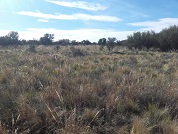Floristic and functional composition of natural grasslands in central Argentina: The effect of ca
DOI:
https://doi.org/10.25260/EA.23.33.1.0.2054Keywords:
plant community, disturbance, livestock farmingAbstract
The state and conservation of the natural resources involved in production systems is of global concern. In Argentina, the expansion of the agricultural frontier from the Humid Pampa to the west has intensified livestock activity in semi-arid areas, decreasing the probability of finding sites that are not severely anthropized for productive purposes. The objectives of this work were to characterize the floristic and functional composition of the herbaceous stratum of caldén forests in a site excluded from domestic grazing in the last 50 years and to compare it with two other situations: one, with a winter fire event and subsequent exclusion of ca
References
Adler, P. B., D. G. Milchunas, W. K. Lauenroth, O. E. Sala, and I. C. Burke. 2004. Functional traits of graminoids in semi‐arid steppes: a test of grazing histories. Journal of Applied Ecology 41:653-663. https://doi.org/10.1111/j.0021-8901.2004.00934.x.
Anderson, D. L., J. A. Del Aguila, and A. E. Bernardón. 1970. Las formaciones vegetales en la provincia de San Luis. Revista de Investigación Agropecuarias INTA 7:153-158.
De Cáceres, M., and P. Legendre. 2009. Associations between species and groups of sites: indices and statistical inference. Ecology 90:3566-3574. https://doi.org/10.1890/08-1823.1.
Díaz, S., S. Lavorel, S. McIntyre, V. Falczuk, F. Casanovess, D. G. Milchunas, C. Skarpe, G. Rusch, M. Sternberg, I. Noy-Meir, J. Landsberg, W. Zhang, H. Clarkss, and B. D. Campbell. 2007. Plant trait responses to grazing a global synthesis. Global Change Biology 13:313-341. https://doi.org/10.1111/j.1365-2486.2006.01288.x.
Di Rienzo, J. A., F. Casanoves, M. G. Balzarini, L. González, M. Tablada, and C. W. Robledo. 2020. Centro de Transferencia InfoStat, FCA, Universidad Nacional de Córdoba, Argentina. URL: infostat.com.ar.
Distel, R. A. 2016. Grazing ecology and the conservation of the Caldenal rangelands, Argentina. Journal of Arid Environments 134:49-55. https://doi.org/10.1016/j.jaridenv.2016.06.019.
Irisarri, J. G. N, and M. Oesterheld. 2020. Temporal variation of stocking rate and primary production in the face of drought and land use change. Agricultural Systems 178:102750. https://doi.org/10.1016/j.agsy.2019.102750.
Mazzola, M., A. Kin, E. Morici, F. Babinec, and G. Tamborini. 2008. Efecto del gradiente altitudinal sobre la vegetación de las Sierras de Lihue Calel (La Pampa, Argentina). Bol Soc Argent Bot 43(1-2):103-119.
Mueller-Dombois, D., and H. Ellenberg. 1974. Aims and Methods of Vegetation Ecology. New York. Wiley. Pp. 574.
Oksanen, J., F. G. Blanchet, R. Kindt, P. Legendre, P. R. Minchin, R. B. O´Hara, et al. 2016. Vegan: community ecology package, R package version 2.3-4. URL: CRAN.R-project.org/package=vegan.
O’Reagain, P. J., and J. C. Scanlan. 2013. Sustainable management for rangelands in a variable climate: evidence and insights from northern Australia. Animal: An International Journal of Animal Bioscience 7:68-78. https://doi.org/10.1017/S175173111100262X.
Oyarzabal, M., J. R. Clavijo, L. J. Oakley, F. Biganzoli, P. M. Tognetti, I. M. Barberis, and M. Oesterheld. 2018. Unidades de vegetación de la Argentina. Ecología Austral 28:40-63. https://doi.org/10.25260/EA.18.28.1.0.399.
Paruelo, J. M., J. P. Guerschman, G. Piñeiro, E. G. Jobbágy, S. R. Verón, G. Baldi, and S. Baeza. 2006. Cambios en el uso de la tierra en Argentina y Uruguay: Marcos conceptuales para su análisis. Agrociencia 2:47-61.
Peña Zubiate, C., D. Anderson, M. Demmi, J. Saenz, and A. D’Hiriart. 1998. Carta de Suelos y Vegetación de la provincia de San Luis. INTA EEA San Luis. Gobierno de la provincia de San Luis. Pp. 105.
Puthod, G. 2018. Mejoramiento del pastizal en el ecotono austral de la Región Pampeana y el Caldenal. Tesis presentada para optar al título de Magister en Ciencias Agrarias. Universidad Nacional del Sur.
Silva, L. C. R., M. A. Giorgis, M. Anand, L. Enrico, N. Pérez-Harguindeguy, V. Falczuk, L. L. Tieszen, and M. Cabido. 2011. Evidence of shift in C4 species range in central Argentina during the late Holocene. Plant Soil 349:261-279. https://doi.org/10.1007/s11104-011-0868-x.
Viglizzo, E., F. Ricard, E. Jobbágy, F. Frank, and L Carreño. 2011. Assessing the cross-scale impact of 50 years of agricultural transformation in Argentina. Field Crops Research 124:186-194. https://doi.org/10.1016/j.fcr.2011.05.014.
Vogel, B., C. M. Rostagno, L. Molina, M. Antilef, and L. La Manna. 2022. Cushion shrubs encroach subhumid rangelands and form fertility islands along a grazing gradient in Patagonia. Plant and Soil 475:623-643. https://doi.org/10.1007/s11104-022-05398-1.
Wang, G., J. Li, and S. Ravi. 2019. A combined grazing and fire management may reverse woody shrub encroachment in desert grasslands. Landscape Ecology 34:2017-2031. https://doi.org/10.1007/s10980-019-00873-0.
Zhang, P., Z. Yang, and J. Wu. 2021. Livestock grazing promotes ecosystem multifunctionality of a coastal salt marsh. Journal of Applied Ecology 58:2124-2134. https://doi.org/10.1111/1365-2664.13957.
Zheng, M., J. Song, J. Ru, Z. Zhou, M. Zhong, Jiang, L. D. Hui, and S. Wan. 2021. Effects of grazing, wind erosion, and dust deposition on plant community composition and structure in a temperate steppe. Ecosystems 24:403-420. https://doi.org/10.1007/s10021-020-00526-3.

Downloads
Published
How to Cite
Issue
Section
License
Copyright (c) 2022 Ruth Rauber, M. Alicia Cendoya, Daniel Arroyo, Stella Bogino

This work is licensed under a Creative Commons Attribution 3.0 Unported License.
Authors retain their rights as follows: 1) by granting the journal the right to its first publication, and 2) by registering the published article with a Creative Commons Attribution License (CC-BY 4.0), which allows authors and third parties to view and use it as long as they clearly mention its origin (citation or reference, including authorship and first publication in this journal). Authors can make other non-exclusive distribution agreements as long as they clearly indicate their origin and are encouraged to widely share and disseminate the published version of their work.


